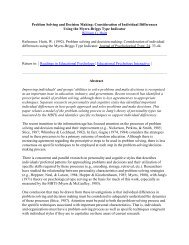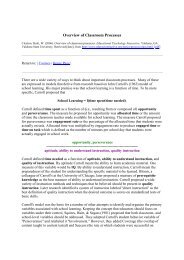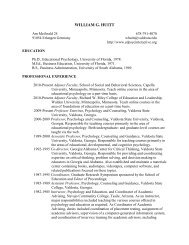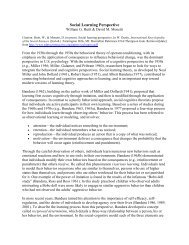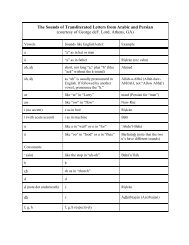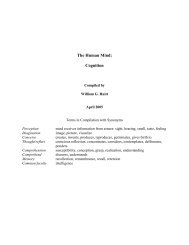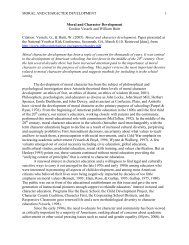Physical Development - Educational Psychology Interactive
Physical Development - Educational Psychology Interactive
Physical Development - Educational Psychology Interactive
You also want an ePaper? Increase the reach of your titles
YUMPU automatically turns print PDFs into web optimized ePapers that Google loves.
PHYSICAL DEVELOPMENT 9<br />
importance of the physical development of children and youth and will begin to advocate a focus<br />
on this domain in schools as well as the home and community.<br />
References<br />
American Fitness Alliance. (2001). <strong>Physical</strong> best: Discover how you can implement healthrelated<br />
physical education effectively. Champaign, IL: Human Kinetics Publishers.<br />
Retrieved August 2, 2004, from http://www.americanfitness.net/<strong>Physical</strong>_Best/<br />
American Heart Association (2004). Dietary guidelines for American children. Retrieved July 8,<br />
2004, from http://www.americanheart.org<br />
American Heart Association (2004). Heart attacks. Retrieved July 2, 2004, from<br />
http://www.americanheart.org<br />
Booth, F., Chakravarthy, M., & Spangenburg, E. (2002). Exercise and gene expression:<br />
physiological regulation of the human genome through physical activity. Journal of<br />
Physiology 543(2), 399-411. Retrieved August 2, 2004, from<br />
http://jp.physoc.org/cgi/reprint/543/2/399.pdf<br />
Centers for Disease Control and Prevention (2000). Promoting better health for people through<br />
physical activity and sports: A report to the President from the Department of Health and<br />
Human Services and the Secretary of Education. Atlanta, GA: U.S. Department of Health<br />
and Human Services, Centers for Disease Control and Prevention, National Center for<br />
Chronic Disease Prevention and Health Promotion.<br />
Cooper, K. (1991). The aerobics program for total well-being: Exercise, diet, emotional balance<br />
(Reissue ed.). New York: Bantam. [Originally published in 1983].<br />
Cooper, K. (1999). Fit kids! The complete shape-up program from birth though high school.<br />
Nashville, TN: Broadman and Holman Publishers.<br />
Cooper Institute, The. (2001). FitnessGram/ActivityGram. Dallas TX: Author. Retrieved August<br />
2, 2004, from http://www.cooperinst.org/ftgmain.asp<br />
Edlin, G., Golanty, E., & Brown, K. (2002). Health and wellness (7th ed.). Sudbury, MA: Jones<br />
& Bartlett.<br />
Huitt, W. (2006). Becoming a Brilliant Star: An introduction. Paper presented at the<br />
International Networking for <strong>Educational</strong> Transformation (iNet) conference, Augusta,<br />
GA, April 23-27. Retrieved November 2006, from<br />
http://www.edpsycinteractive.org/brilstar/brilstarintro_s.pdf<br />
Kong, D. (1999, November 9). Exercise seen boosting children’s brain function. The Boston<br />
Globe, p.A1.<br />
Kurz, T. (1994). Stretching scientifically (3 rd ed). Island Pond, VT: Stadion Publishing Company,<br />
Inc.<br />
Laino, C. (2003, June 16). One in three kids will develop diabetes. Retrieved June 30, 2004, from<br />
http://my.webmd.com/content/article/66/79851.htm<br />
National Center for Chronic Disease Prevention and Health Promotion. (2004). Body mass index<br />
calculator. Atlanta, GA: Centers for Disease Control and Prevention (CDC). Retrieved<br />
August 2, 2004, from http://www.cdc.gov/nccdphp/dnpa/bmi/calc-bmi.htm<br />
New York Online Access to Health. (2004). Ask NOAH about: <strong>Physical</strong> fitness and exercise.<br />
Retrieved August 2, 2004, from http://www.noahhealth.org/english/wellness/healthyliving/exercise.html



